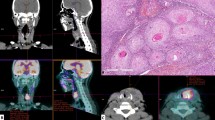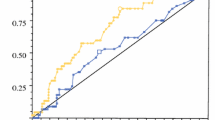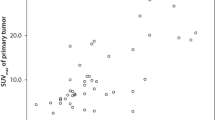Abstract
Objective: Fluorine-18-fluorodeoxyglucose positron emission tomography (FDG-PET) is sometimes used as a means of follow-up after diagnosis and treatment of cancers of the head and neck region. The present study was undertaken to evaluate the ability of FDG-PET to detect local residual tumor after treatment of laryngeal cancer.Methods: Thirty-six patients with laryngeal cancer underwent FDG-PET before and after initial treatment. Of these patients, 20 received FDG-PET before treatment and 28 received it after treatment. The relationship between standardized uptake values (SUV) and the presence or absence of local residual tumor was investigated by setting the cut-off value of the SUV using the receiver operating characteristics (ROC) curve.Results: When the pre-treatment SUV threshold for laryngeal cancer was set at 7.20, the detection of local residual tumor after treatment using FDG-PET had a sensitivity of 77.78%, specificity of 81.82%, false positive rate of 18.18%, false negative rate of 22.22%, accuracy of 80% and a p value of 0.02. When the post-treatment SUV threshold for the larynx was set at 3.35, the test had a sensitivity of 93.75%, specificity of 91.67%, false positive rate of 8.33%, false negative rate of 6.25%, accuracy of 92.86% and a p value of 0.0001.Conclusions: FDG-PET was found to be useful for determining the presence of local residual tumor after treatment of laryngeal cancer.
Similar content being viewed by others
References
Van den Abbeele AD, Badawi RD. Use of positron emission tomography in oncology and its potential role to assess response to imatinib mesylate therapy in gastrointestinal stromal tumors (GISTs).Eur J Cancer 2002; 38 (Suppl 5): S60–65.
Kitagawa Y, Nishizawa S, Sano K, Ogasawara T, Nakamura M, Sadato N, et al. Prospective comparison of18F-FDG PET with conventional imaging modalities (MRI, CT, and67Ga scintigraphy) in assessment of combined intraarterial chemotherapy and radiotherapy for head and neck carcinoma.J Nucl Med 2003; 44: 198–206.
Sakamoto H, Nakai Y, Ohashi Y, Matsuda M, Sakashita T, Nasako Y, et al. Monitoring of response to radiotherapy with fluorine-18 deoxyglucose PET of head and neck squamous cell carcinomas.Acta Otolaryngol 1998; 538 (Suppl): 254–260.
Kubota K, Yokoyama J, Yamaguchi K, Ono S, Qureshy A, Itoh M, et al. FDG-PET delayed imaging for the detection of head and neck cancer recurrence after radio-chemotherapy: comparison with MRI/CT.Eur J Nucl Med Mol Imaging 2004; 31: 590–595.
Kubota K. From tumor biology to clinical PET: A review of positron emission tomography (PET) in oncology.Ann Nucl Med 2001; 15: 471–486.
Kelloff GJ, Hoffman JM, Johnson B, Scher HI, Siegel BA, Cheng EY, et al. Progress and promise of FDG-PET imaging for cancer patient management and oncologic drug development.Clin Cancer Res 2005; 11: 2785–2808.
Strauss LG, Conti PS. The applications of PET in clinical oncology.J Nucl Med 1991; 32: 623–648.
Strauss LG. Positron Emission Tomography: Current Role for Diagnosis and Therapy Monitoring in Oncology.Oncologist 1997; 2: 381–388.
Kawabe J, Okamura T, Shakudo M, Koyama K, Sakamoto H, Ohachi Y, et al. Physiological FDG uptake in the palatine tonsils.Ann Nucl Med 2001; 15: 297–300.
Schwartz DL, Rajendran J, Yueh B, Coltrera MD, Leblanc M, Eary J, et al. FDG-PET prediction of head and neck squamous cell cancer outcomes.Arch Otolaryngol Head Neck Surg 2004; 130: 1361–1367.
Halfpenny W, Hain SF, Biassoni L, Maisey MN, Sherman JA, McGurk M. FDG-PET. A possible prognostic factor in head and neck cancer.Br J Cancer 2002; 86: 512–516.
Kitagawa Y, Sano K, Nishizawa S, Nakamura M, Ogasawara T, Sadato N, et al. FDG-PET for prediction of tumour aggressiveness and response to intra-arterial chemotherapy and radiotherapy in head and neck cancer.Eur J Nucl Med Mol Imaging 2003; 30: 63–71.
Allal AS, Dulguerov P, Allaoua M, Haenggeli CA, El-Ghaziel A, Lehmann W, et al. Standardized uptake value of 2-[(18)F]fluoro-2-deoxy-d-glucose in predicting outcome in head and neck carcinomas treated by radiotherapy with or without chemotherapy.J Clin Oncol 2002; 20: 1398–1404.
Minn H, Lapela M, Klemi PJ, Grenman R, Leskinen S, Lindholm P, et al. Prediction of survival with fluorine-18-fluoro-deoxyglucose and PET in head and neck cancer.J Nucl Med.1997; 38: 1907–1911.
Brun E, Kjellen E, Tennvall J, Ohlsson T, Sandell A, Perfekt R, et al. FDG PET studies during treatment: prediction of therapy outcome in head and neck squamous cell carcinoma.Head Neck 2002; 24: 127–135.
Terhaard CH, Bongers V, van Rijk PP, Hordijk GJ. F-18-fluoro-deoxy-glucose positron-emission tomography scanning in detection of local recurrence after radiotherapy for laryngeal/pharyngeal cancer.Head Neck 2001; 23: 933–941.
Haenggeli CA, Dulguerov P, Slosman D, Becker M, Bang P, Allal A, et al. Value of positron emission tomography with 18-fluorodeoxyglucose (FDG-PET) in early detection of residual tumor in oro-pharyngeal-laryngeal carcinoma.Schweiz Med Wochenschr 2000; 116 (Suppl): 8S-11S.
Cheon GJ, Chung JK, So Y, Choi JY, Kim BT, Jeong JM, et al. Diagnostic Accuracy of F-18 FDG-PET in the Assessment of Posttherapeutic Recurrence of Head and Neck Cancer.Clin Positron Imaging 1999; 2: 197–204.
Conessa C, Herve S, Foehrenbach H, Poncet JL. FDG-PET scan in local follow-up of irradiated head and neck squamous cell carcinomas.Ann Otol Rhinol Laryngol 2004; 113: 628–635.
Greven KM, Williams DW 3rd, Keyes JW Jr, McGuirt WF, Watson NE Jr, Case LD. Can positron emission tomography distinguish tumor recurrence from irradiation sequelae in patients treated for larynx cancer?Cancer J Sci Am 1997; 3: 353–357.
McGuirt WF, Greven K, Williams D 3rd, Keyes JW Jr, Watson N, Cappellari JO. PET scanning in head and neck oncology: a review.Head Neck 1998; 20: 208–215.
Wong RJ, Lin DT, Schoder H, Patel SG, Gonen M, Wolden S, et al. Diagnostic and prognostic value of [(18)F]fluorodeoxyglucose positron emission tomography for recurrent head and neck squamous cell carcinoma.J Clin Oncol 2002; 20: 4199–4208.
Hanna E, Sherman A, Cash D, Adams D, Vural E, Fan CY. Quality of life for patients following total laryngectomy vs chemoradiation for laryngeal preservation.Arch Otolaryngol Head Neck Surg 2004; 130: 875–879.
Author information
Authors and Affiliations
Rights and permissions
About this article
Cite this article
Oe, A., Kawabe, J., Torii, K. et al. Detection of local residual tumor after laryngeal cancer treatment using FDG-PET. Ann Nucl Med 21, 9–13 (2007). https://doi.org/10.1007/BF03033994
Received:
Revised:
Issue Date:
DOI: https://doi.org/10.1007/BF03033994




